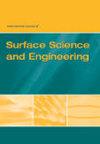Microstructure and wear behaviour of laser hardened SAE 4130 steels
IF 1.2
4区 工程技术
Q4 ENGINEERING, MECHANICAL
International Journal of Surface Science and Engineering
Pub Date : 2018-04-18
DOI:10.1504/IJSURFSE.2018.10012334
引用次数: 6
Abstract
Low alloy SAE 4130 steel had been laser hardened for the microstructure, hardness and wear characterisation. An almost fully martensitic layer, with case depth of approximately 0.5 mm, was obtained by defocusing a fibre laser by 50 mm. The best results were produced by 600 W laser powers, a beam defocusing of 50 mm and a speed of 8 or 10 mm/s, where a maximum hardness of 390 HV was obtained compared to 220 HV of the base material. The laser treated surfaces presented a combination of oxides and wear behaviour distinctly superior to the bare surface. The coefficients of friction (COF) of the lasered surfaces were approximately half of the bare condition. The average COF maximum value and standard deviation was superior for the bare compared to the lasered conditions. Finally, the wear rate is three times larger in the unlasered sample compared to the laser treated ones.激光硬化sae4130钢的显微组织和磨损性能
对低合金sae4130钢的显微组织、硬度和磨损特性进行了激光硬化处理。通过光纤激光器离焦50mm,获得了几乎完全的马氏体层,层深约0.5 mm。当激光功率为600 W,光束离焦为50 mm,速度为8或10 mm/s时,获得的最佳结果为390 HV,而基材的最大硬度为220 HV。激光处理的表面呈现出氧化物和磨损性能明显优于裸表面的组合。激光表面的摩擦系数(COF)约为裸状态的一半。裸机条件下的平均COF最大值和标准差优于激光条件。最后,与激光处理样品相比,未激光处理样品的磨损率是激光处理样品的三倍。
本文章由计算机程序翻译,如有差异,请以英文原文为准。
求助全文
约1分钟内获得全文
求助全文
来源期刊
CiteScore
1.60
自引率
25.00%
发文量
21
审稿时长
>12 weeks
期刊介绍:
IJSurfSE publishes refereed quality papers in the broad field of surface science and engineering including tribology, but with a special emphasis on the research and development in friction, wear, coatings and surface modification processes such as surface treatment, cladding, machining, polishing and grinding, across multiple scales from nanoscopic to macroscopic dimensions. High-integrity and high-performance surfaces of components have become a central research area in the professional community whose aim is to develop highly reliable ultra-precision devices.

 求助内容:
求助内容: 应助结果提醒方式:
应助结果提醒方式:


